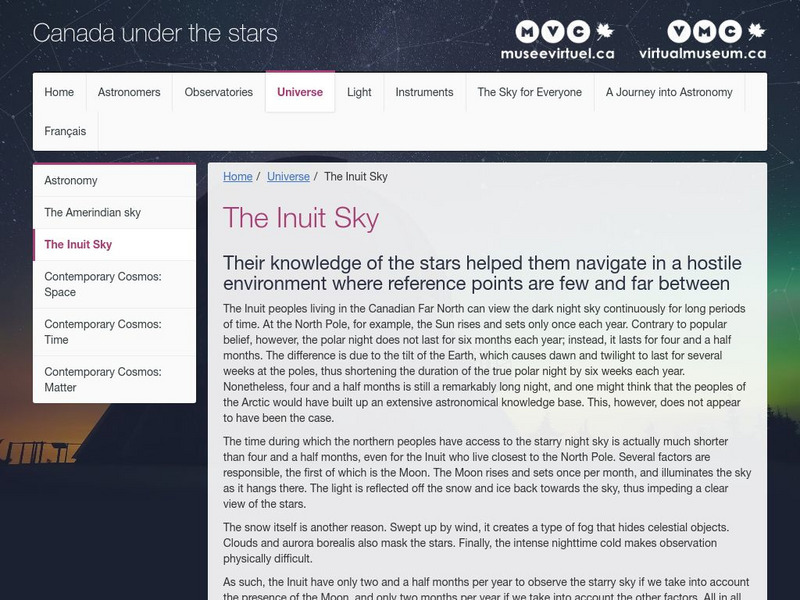Hi, what do you want to do?
Curated OER
Sunny Symbols
After listening to a series of stories about signs and symbols associated with the United States, pupils discuss the importance of the sun in Native American legends and as a representation of New Mexico. As part of this exploration,...
Curated OER
Working on the Moon
Young scholars take a mission to the moon. In this space science lesson, students visit selected websites to discover information about Earth's moon and the solar system. Young scholars may take virtual missions to the moon and...
Curated OER
The Civil War in Art and Literature
Pupils examine art related to the Civil War. They participate in activities that allow them to write poetry and drawings. They create their own journal and collect their work in a binder.
Curated OER
Sky Watchers: Ancient Astronomers
Students close their eyes and picture the sky. They are asked to brainstorm things they may see in the course of a night and day, such as the movement of the sun, moon, and stars. Students work in groups to coduct their research. They...
Curated OER
Engaging Students with the History of Time
Researching the history of calendars and time-keeping devices can help students make sense of time measurement.
Curated OER
Learning about a Culture from a Story
Students interpret the identity of a traditional culture from objects and a creation story. In this lesson on learning about a culture from a story, students read and analyze an Eskimo myth about creation and an essay on Traditional...
Curated OER
GPS Treasure Hunt for Knowledge
Students examine themselves as being part of a global community. For this global community lesson, students investigate GPS systems. Students gain knowledge on how the device works. Students discover that satellites provide information...
Curated OER
Technology of the Ancient World Lesson Plans
Technology of the ancient world lesson plans can open students' eyes to the influence of early innovations.
Curated OER
Ptolemy, Copernicus, & the Church
Students determine the difference between a geocentric universe and a heliocentric universe.
Curated OER
Ptolemy, Copernicus, & the Church
Students explore the scientific revolution. In this scientific revolution instructional activity, students complete activities regarding Ptolemy, Copernicus, and the Church.
Curated OER
Grade 8: Intermediate-Level Test, Science Written Test, 2004
In this 8th grade science standardized test practice worksheet, 8th graders respond to 78 multiple choice and short answer questions that require them to review their knowledge of science.
Curated OER
Naval Warfare in the American Revolution
Students determine speed and bearing, calculate a position by dead reckoning, and modify this position using vectors for wind and current drift.
Curated OER
What Would You Take to Sea? Instructions for Teachers
Students, who are teachers, discover the hazards facing sailors hundreds of years ago as they prepare a instructional activity to use in their classroom. They examine what each group of students will investigate, and how the findings...
Curated OER
God vs. god
Middle schoolers recognize the power of God and see Him as the Creator of all. In this Bible studies lesson, students examine selections from the Bible and understand how God has shown Himself to be the one true God.
Curated OER
Learning about a Culture from a Story
Students identify environmental influences on a traditional culture, animals and plants important to a traditional culture, and interpret the identity of a traditional culture from objects and a creation story.
Curated OER
Sky Watching
Students complete night-sky observations to understand how our knowledge of the sky has been enhanced by telescopes. Students complete a timeline worksheet giving the history of telescopes. Students then then make their own observations...
Other
Vmc: The Inuits the Sky of the First Inhabitants
The Inuit's knowledge of the stars helped them navigate in a hostile environment. In their legends, they did view the the Sun as being a woman, and the Moon as a man. Several stories are shared here.
Institute and Museum of the History of Science
Museo Galileo: Multimedia: Video: Astronomical Use of the Plane Astrolabe
Invented in ancient Egypt, the plane astrolabe is a tool used by astronomers and navigators to determine time and identifying positions of the Sun, Moon, stars, and planets. Read text or view the video to understand the details of its...






















